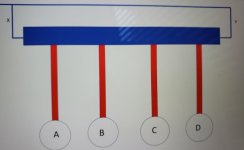I have a friendly argument going. This oil manifold is fed from single source, and all of the branches feeding Machines A-D are the same size.
Expert #1 says the best way to plumb this oil manifold is from one end only, let's use X. Using this method, each machine (A through D) will get a good and equal supply of oil.
Expert #2 says it's better to 'loop' plumb the supply from X and Y so that the manifold is more equally pressurized. This way, Machine D won't see less pressure than Machine A when you feed oil in from X.
Expert #1 says if you plumb from both ends, the oil flow from X and Y will 'smash' into each other as opposing forces and create a situation where there will be good pressure but poor flow.
Expert #3 says if you single-feed the manifold from X, the oil will want to flow past ABC and will end up over-feeding D as it is the last branch. C will get more oil than B, but both will get less than D. A will get the least oil of all.
So who understands real-world flow results? Lots of theory, as you can see, but what matters is what really happens.

Expert #1 says the best way to plumb this oil manifold is from one end only, let's use X. Using this method, each machine (A through D) will get a good and equal supply of oil.
Expert #2 says it's better to 'loop' plumb the supply from X and Y so that the manifold is more equally pressurized. This way, Machine D won't see less pressure than Machine A when you feed oil in from X.
Expert #1 says if you plumb from both ends, the oil flow from X and Y will 'smash' into each other as opposing forces and create a situation where there will be good pressure but poor flow.
Expert #3 says if you single-feed the manifold from X, the oil will want to flow past ABC and will end up over-feeding D as it is the last branch. C will get more oil than B, but both will get less than D. A will get the least oil of all.
So who understands real-world flow results? Lots of theory, as you can see, but what matters is what really happens.



